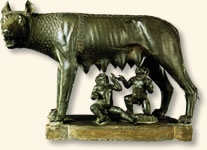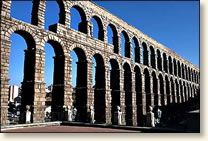|
The Grandeur of Rome, 75 AD

A she-wolf suckles the infants
Romulus and Remis
the founders od Rome
|
Legend tells us that Ancient Rome was founded by two brothers – Romulus and Remus - in the heart of the Italian peninsula some seven-hundred-fifty years before the birth of Christ. Over the next seven centuries Rome grew from a city state to an empire that dominated the known world bordering the Mediterranean Sea and beyond. In the process, the city itself was transformed from a meager village to a metropolis that by the year 75 AD numbered an estimated 1.5 million inhabitants. It was the center of the known world, the seat of imperial power and the home of numerous architectural wonders.
The Roman historian Pliny the Elder provides us with a snapshot of Rome's architectural grandeur in the year 75 AD that includes buildings inhabited for over 700 years and newly erected wonders of the Ancient World:
The Great Buildings
"[In great buildings] as well as in other things the rest of the world has been outdone by us Romans. If, indeed, all the buildings in our City are considered in the aggregate, and supposing them - so to say - all thrown together in one vast mass, the united grandeur of them would lead one to imagine that we were describing another world, accumulated in a single spot.
Not to mention among our great works the Circus Maximus, that was built by the Dictator Caesar - one stadium broad and three in length - and occupying with the adjacent buildings no less than four iugera [about 2 acres] with room for no less than 160,000 spectators seated - am I not, however, to include in the number of our magnificent structures the Basilica of Paulus with its admirable Phrygian columns [built also in Julius Caesar's day], the Forum of the late Emperor Augustus, the Temple of Peace erected by the Emperor Vespasian Augustus - some of the finest work the world has ever seen? [and many others].
The Sewer System
Frequently praise is given to the great sewer system of Rome. There are seven 'rivers' made to flow, by artificial channels, beneath the city. Rushing onward like so many impetuous torrents, they are compelled to carry off and sweep away all the sewerage; and swollen as they are by the vast accession of the rain water, they reverberate against the sides and bottoms of their channels. Occasionally too the Tiber, overflowing, is thrown backward in its course, and discharges itself by these outlets. Obstinate is the struggle that ensues between the meeting tides, but so firm and solid is the masonry that it is able to offer an effectual resistance. Enormous as are the accumulations that are carried along above, the work of the channels never gives way. Houses falling spontaneously to ruins, or leveled with the ground by conflagrations are continually battering against them; now and then the ground is shaken by earthquakes, and yet - built as they were in the days of Tarquinius Priscus, seven hundred years ago - these constructions have survived, all but unharmed.

A Roman aqueduct
|
Supplying Water to the City
But let us now turn our attention to some marvels that, if justly appreciated, may be pronounced to remain unsurpassed. Quintus Marcius Rex [praetor in 144 B.C.] upon being commanded by the Senate to repair the Appian Aqueduct and that of the Anio, constructed during his praetorship a new aqueduct that bore his name, and was brought hither by a channel pierced through the very sides of mountains. Agrippa, during his aedileship, united the Marcian and the Virgin Aqueducts and repaired and strengthened the channels of others. He also formed 700 wells, in addition to 500 fountains, and 130 reservoirs, many of them magnificently adorned. Upon these works too he erected 300 statues of marble or bronze, and 400 marble columns, and all this in the space of a single year! In the work which he has written in commemoration of his aedileship, he also informs us that public games were celebrated for the space of fifty-seven days and 170 gratuitous bathing places were opened to the public. The number of these at Rome has vastly increased since his time.
The preceding aqueducts, however, have all been surpassed by the costly work which has more recently been completed by the Emperors Gaius [Caligula] and Claudius. Under these princes the Curtian and the Caerulean Waters with the 'New Anio' were brought a distance of forty miles, and at so high a level that all the hills - whereon Rome is built - were supplied with water. The sum expended on these works was 350,000,000 sesterces. If we take into account the abundant supply of water to the public, for baths, ponds, canals, household purposes, gardens, places in the suburbs and country houses, and then reflect upon the distances that are traversed from the sources on the hills, the arches that have been constructed, the mountains pierced, the valleys leveled, we must perforce admit that there is nothing more worthy of our admiration throughout the whole universe."
References:
This eyewitness account appears in: Davis, William Sterns, Readings in Ancient History (1912).
How To Cite This Article:
"The Grandeur of Rome, 75 AD" EyeWitness to History, www.eyewitnesstohistory.com (2009).
|






